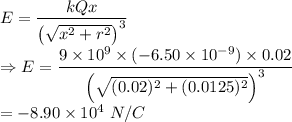
Physics, 10.09.2019 04:30 allyssaharrisooy50au
Acharge of -6.50 nc is spread unifonnly over the surface of one face of a nonconducting disk of radius 1.25 cm. (a) find the
magnitude and direction of the electric field this disk produces at a point p on the axis of the disk a distance of 2.00 cm from its center. (b) suppose that the charge were all pushed away from the center and distributed unifonnly on the outer rim of the disk. find the magnitude and direction of the electric field at point p. (c) if the charge is all brought tn the center of the disk, find the magnitude and direction of the electric field at point p. (d) why is the field in part (a) stronger than the field in part (b)? why is the field in part (c) the strongest of the three fields?

Answers: 1


Another question on Physics

Physics, 22.06.2019 09:40
Which is special about a dc circuit ? a. it has both series and parallel components b. it has only series or only parallel components c. charge moves in a single direction d. charge moves back and forth quickly
Answers: 3

Physics, 22.06.2019 16:30
One number is said to be an "order of magnitude" larger than another number if choose one: a. it is 10 times larger. b. it is 5 times larger. c. it is 3 times larger. d. it is 100 times larger. e. it is 2 times larger.
Answers: 1

Physics, 22.06.2019 22:00
Ihave this 50 question test the layer of earth's atmosphere where atoms and molecules escape into space is referred to as the a) exosphere b) ionosphere. c) mesosphere d) thermosphere
Answers: 1

Physics, 22.06.2019 23:00
Acommon technique in analysis of scientific data is normalization. the purpose of normalizing data is to eliminate irrelevant constants that can obscure the salient features of the data. the goal of this experiment is to test the hypothesis that the flux of light decreases as the square of the distance from the source. in this case, the absolute value of the voltage measured by the photometer is irrelevant; only the relative value conveys useful information. suppose that in part 2.2.2 of the experiment, students obtain a signal value of 162 mv at a distance of 4 cm and a value of 86 mv at a distance of 5.7 cm. normalize the students' data to the value obtained at 4 cm. (divide the signal value by 162.) then calculate the theoretically expected (normalized) value at 5.7 cm.
Answers: 2
You know the right answer?
Acharge of -6.50 nc is spread unifonnly over the surface of one face of a nonconducting disk of radi...
Questions


Business, 05.07.2019 16:00







Health, 05.07.2019 16:00



English, 05.07.2019 16:00

English, 05.07.2019 16:00

Mathematics, 05.07.2019 16:00

Mathematics, 05.07.2019 16:00



Chemistry, 05.07.2019 16:00





 Q = Uniformly spread charge on the disc =
Q = Uniformly spread charge on the disc =  x = distance of the point P from the center of disc on its axis = 2 cm = 0.02 m
r = radius of the disc = 1.25 cm = 0.0125 m
x = distance of the point P from the center of disc on its axis = 2 cm = 0.02 m
r = radius of the disc = 1.25 cm = 0.0125 m





